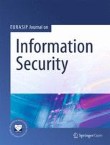Performance comparison of quantum-safe multivariate polynomial public key encapsulation algorithm
A novel quantum-safe key encapsulation algorithm, called Multivariate Polynomial Public Key (MPPK), was recently proposed by Kuang, Perepechaenko, and Barbeau. Security of the MPPK key encapsulation mechanism ...

